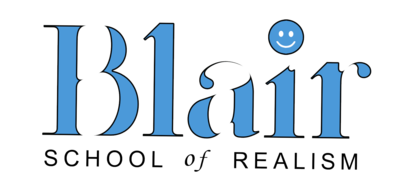One of the biggest misconceptions about improving one's artistic skills is that all you need to do is practice. Many people tout the phrase "practice practice practice."
However, I've come to the conclusion that artistic growth is not about doing the same exercise again and again until you become proficient, and artistic growth doesn't come from making 10,000 brush strokes. It comes from understanding how to interpret visual elements. In other words, you need to focus on improving your visual skills. Technique is useless if you cannot see the subject properly.

It's not about who can make the finest line
I often see artists overemphasizing technique when training. While some technique is necessary, it is not the most important quality needed for superior results. Many times, I've observed artists who possess great airbrush control, yet had mediocre paintings, because they had failed to develop their observational skills.
Quality matters
Practicing bad technique does an artist no good. They end up reinforcing bad habits and compromising the quality of their work. It's more important to train for shorter periods correctly than for extended periods with bad form.
How to train
For the fastest growth, you need to train to failure. It's not unlike going to the gym. You won't experience great gains unless you push yourself further, even to the point of suffering a bit.
Instead of practicing the same exercise over and over, take on a challenging subject. Yes, you will fail and screw it up, but in doing so, you will learn so much more than if you repeated an easy exercise over and over.
Try taking on an "impossible" project that is beyond your current skill level. You'll experience many failures, but in doing so, you will arrive at new revelations. In my early years, I attempted paintings that were, in my mind, impossible, but every mistake I made (and there were many), came with the gift of understanding.
You learn more from your failures than your successes.
It's not pleasant to fail, but in doing so, you learn more than you would from succeeding. Think about how you never forget those costly lessons in life. The same goes for airbrushing.
Playing it safe retards growth
The next time you find yourself saying, "I'll paint that when I get better," or "I'll take that workshop after I improve," stop and realize that your best path towards rapid improvement is to shoot for the moon. If you only make it halfway there, you've still gone further than you would by not trying. It's really just a matter of how fast you want to grow.

Don't fear failure. The worst thing that can happen is that you will learn something.





Rickie Sny
August 27, 2023
The learning process is making mistakes throughout a lifetime. Some mistakes could possibly result in new discoveries. We all have experienced trying to correct mistakes. That is the learning process. And a lifetime of mistakes enables problem solving skills.
Rickie Sny
August 27, 2023
President Franklin D. Roosevelt once quoted, "The only thing to fear is fear itself. "
As fear keeps us trapped in a bubble or boundaries.
Lisa Smarr
August 27, 2023
Dru,
I love your gym analogy as it relates to stretching one’s artistic reach on the canvas. In any discipline we become stagnant if we fail to take the leap and challenge ourselves.
Thank you for encouragement.
I like your choice of illustration.
Best,
Lisa Smarr
Randy Nash
August 27, 2023
Dru this article is spot on thank you for the feedback
Don
August 27, 2023
Hi Blair Think there is something in what’s in above. I have sorta been trying this just not realised it. I can try it with my eyes open. My subject it Fire.
Joanna Wood
August 27, 2023
This is all very true, especially about the observational skills. In my journey, I have been forcing myself to really study my subject and then move slower through the process of painting it. This is to observe my progress against the reference before moving on. Stepping away periodically is also necessary for me to keep fresh eyes on the project as much as possible. I still need to work on breaking bad technical habits, but that is coming along with slowing down to observe what I’m doing and how I’m doing it. Thanks, Dru.
Sherryl
August 27, 2023
Your 1 liner from Perth workshop still stays with me – Paint what you SEE not what you KNOW.
John
August 27, 2023
I agree whit what you said as I started drawing when I was about 8 or 10 years old. I would draw the pirate in the magazines from some art studio till I got it right and I would learn more and more as I fix mistakes in my work.as for airbrushing I didn’t have alot of experience using the airbrush(about a week in high school art class) Now having airbrushed for a few years I’m still learning with help from people like you so thank you
Katharine Andrews
April 16, 2024
As someone else has said, your words resonate in my head “Paint what you see, not what you know” I have quoted you so many times when friends have come to me for advice. I find another helpful learning curve is to paint something that you wouldn’t normally paint, or something that you don’t like. Because it isnt something that has been instilled in your brain, you have to keep looking back to your reference. Also recommended because if you want to paint for a living you need to be diverse, customers aren’t always going to ask you to paint something you like.
JON BRADY
March 14, 2025
Sounds like good common sense, I’m a newbie, and I found in practice I start getting sloppy very quickly when doing so, I like the idea of just going for it, and learn from my mistakes, thanks Dru